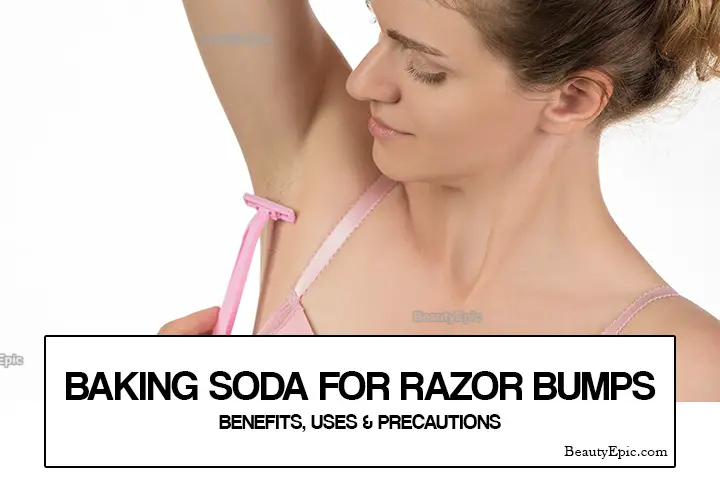
Important: This article is for informational purposes only. Please read our full disclaimer for more details.
Razor bumps also called pseudofolliculitis barbae. It happens when the shaved hair re-grows, curls, and then grows back in the skin. This is a condition which can develop in men, as well as women. Baking soda is used for several purposes which include getting rid of razor bumps.
Article Contains
Does Baking Soda Work on Razor Bumps?
Baking soda is pretty effective when it comes to treating razor bumps. In fact, it can also overcome inflammation and itching that accompanies it. As it is available in powder form, you have to prepare a paste before applying it.
1. Baking Soda and Lemon Juice

Lemon juice is acidic. Thus, it can help in stopping the bacteria from colonizing the hair follicle which is growing inside.
Things Required
- Lemon Juice and,
- Baking Soda.
How to Do
- You can prepare a mix of lemon juice and baking soda.
- Take two tablespoons of lemon juice and a tablespoon of baking soda.
- Mix it and apply the paste on the affected area.
- Leave it for 10 minutes and wash it with warm water.
- Apply this every time you shave.
Best Time to Apply: Before Bath.
No of Repetitions: Apply this every time you shave.
[ Read: Aspirin for Razor Bumps ]
2. Baking Soda and Coconut Oil

Coconut oil has anti-inflammatory properties which help in reducing swelling and redness. It can also reduce bacterial infection. You can easily prepare your natural scrub just by mixing virgin coconut oil and baking soda.
Things Required
- Baking soda and,
- Coconut oil.
How to Do
- To prepare the scrub, you need to two tablespoons of virgin coconut oil and one tablespoon of baking soda. You will have a thick paste.
- In case you have sensitive skin, you should reduce the quantity of baking soda and increase the quantity of coconut oil.
- Apply the paste on the razor bump and leave it for few minutes. Wash it off with warm water.
Best Time to Apply: Before Bath.
No of Repetitions: Do this once or twice in a week.
[ Read: Apple Cider Vinegar for Razor Bumps ]
3. Baking Soda and Vinegar
Vinegar is another remedy to get rid of razor bumps. This will help in reducing itching sensation and inflammation because of the anti-inflammatory properties.
Things Required
- Baking Soda and
- Vinegar
How to Do
- Prepare a paste by mixing one tablespoon of baking soda and two tablespoons of vinegar.
- Mix it properly and apply it on the affected areas. Leave it for 10 minutes and rinse it off with warm water.
Best Time to Apply: Before Bath.
No of Repetitions: Apply it once or twice in a week for the best result.
[ Read: How to Shave Female Pubic Hair ]
4. Baking Soda and Water
Baking soda is an old fashioned remedy when it comes to razor burn and razor bumps.
Things Required
- Baking Soda
- Water.
How to Do
- Mix a tablespoon of baking soda with a cup of water.
- Apply this paste on the affected areas using a cotton ball.
- Allow it to dry for a few minutes. Rinse it off with cold water.
Best Time to Apply: Before Bath.
No of Repetitions: Repeat the procedure once or twice in a day.
Precautions
- Baking soda can dry out your skin. So, be careful to apply moisturizer immediately after your rinse of the baking soda.
- In case you have sensitive skin, you should do a patch test prior to applying.
It is always better to prevent a razor bump than to cure it. - Use a clean razor every day to prevent it. Also, soften your hair with warm water prior to shaving. Make sure that you do not use a dull and old razor.
You Might Also Like
- What’s Causing This Bump on My Forehead, and Should I Be Concerned?
- Why Do I Have A Bump On My Nose?
- How to Get Rid of Razor Bumps Using Aloe Vera?
- Bump on the Side Foot – Common Causes & Treatment Options
- How to Get Rid of a Nose Piercing Bump?
- Why Do I Have White Bumps on My Tongue?
- How to Use Aspirin for Razor Bumps
- How to Get Rid of Razor Bumps In The Bikini Area?
- Tea Tree oil for Razor Bumps – Benefits and Uses
- The 12 Best Home Remedies To Get Rid Of Razor Bumps Fast
- How to Tell If It’s Herpes or Razor Bumps? Causes, Symptoms and Treatment
- Embrace the Secrets of Silky-Smooth Skin
- Apple Cider Vinegar for Razor Bumps – Benefits and Uses
- 7 Best Razors For Sensitive Skin
- How to Get Rid of Razor Bumps Naturally at Home
- How to Get Rid of Ingrown Hair with Baking Soda
- Best Razors For Sensitive Skin
















